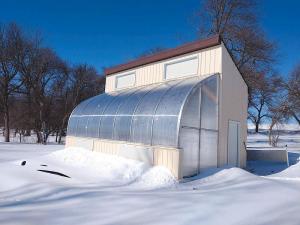In South Dakota, soybeans, corn, wheat, sunflowers, and alfalfa come to mind when contemplating the state’s number one industry - agriculture. However, in Aurora, South Dakota, some of the crops at Wayward Springs have veered in a different, more exotic direction.
Shannon Mutschelknaus is a mechanical engineer and a farmer at Wayward Springs. As a child, he developed an interest in horticulture and eventually began saving seeds and growing tropical and sub-tropical trees. It wasn’t long before he discovered a market demand for exotic tropical fruit trees.
“I discovered the demand for exotic tropical fruit trees was robust because seasonal hurricanes regularly ravage them,” explained Mutschelknaus.
Mutschelknaus wanted to use his engineering, research, and horticulture expertise to build a specialized greenhouse to expand his exotic plant business. With support from a $9,000 NCR-SARE Farmer Rancher grant, he compared the design trade-offs of multiple passive solar greenhouse technologies. He was able to apply the data gleaned from his research to inform how he built a passive solar greenhouse with a “climate battery.
In his greenhouse, Mutschelknaus now grows crops like leafy greens, peppers, tomatoes, and novel fruits like passion fruit, loquats, soursops, and cherimoya. He shared a list of his most successful produce for local customers and sauce producers:•
- Naranjilla has proven to be a delicious, productive citrus/kiwi-like fruit that is attractive to the local flavor palate.
- Super hot peppers, like Carolina Reaper, Apocalypse Scorpions, and Habanero have been very successful for sauce makers. Mutschelknaus is currently growing Carolina Reaper peppers for Halogi, whose hot sauce has been featured on the popular YouTube series Hot Ones.
- Passion fruit sells easily to local customers, especially to producers of sauces.
Many have expressed interest in the design and outcomes of his project.
“With growing fossil fuel costs, the benefit of solar heat storage systems like this start to make fi cal sense,” said Mutschelknaus. “This prototype is small for commercial production but can easily be adapted to larger sizes or even high tunnels. The correct tubing layout and fan selection are key to an effective system.”
Dig Deeper
- Read a Farm Show story about the solar greenhouse.
- Watch Mutschelknaus's 2-part video series about building a passive solar greenhouse.
View Related SARE Grant:
- High Efficiency Year-Round Tropical Greenhouse (FNC19-1185)
